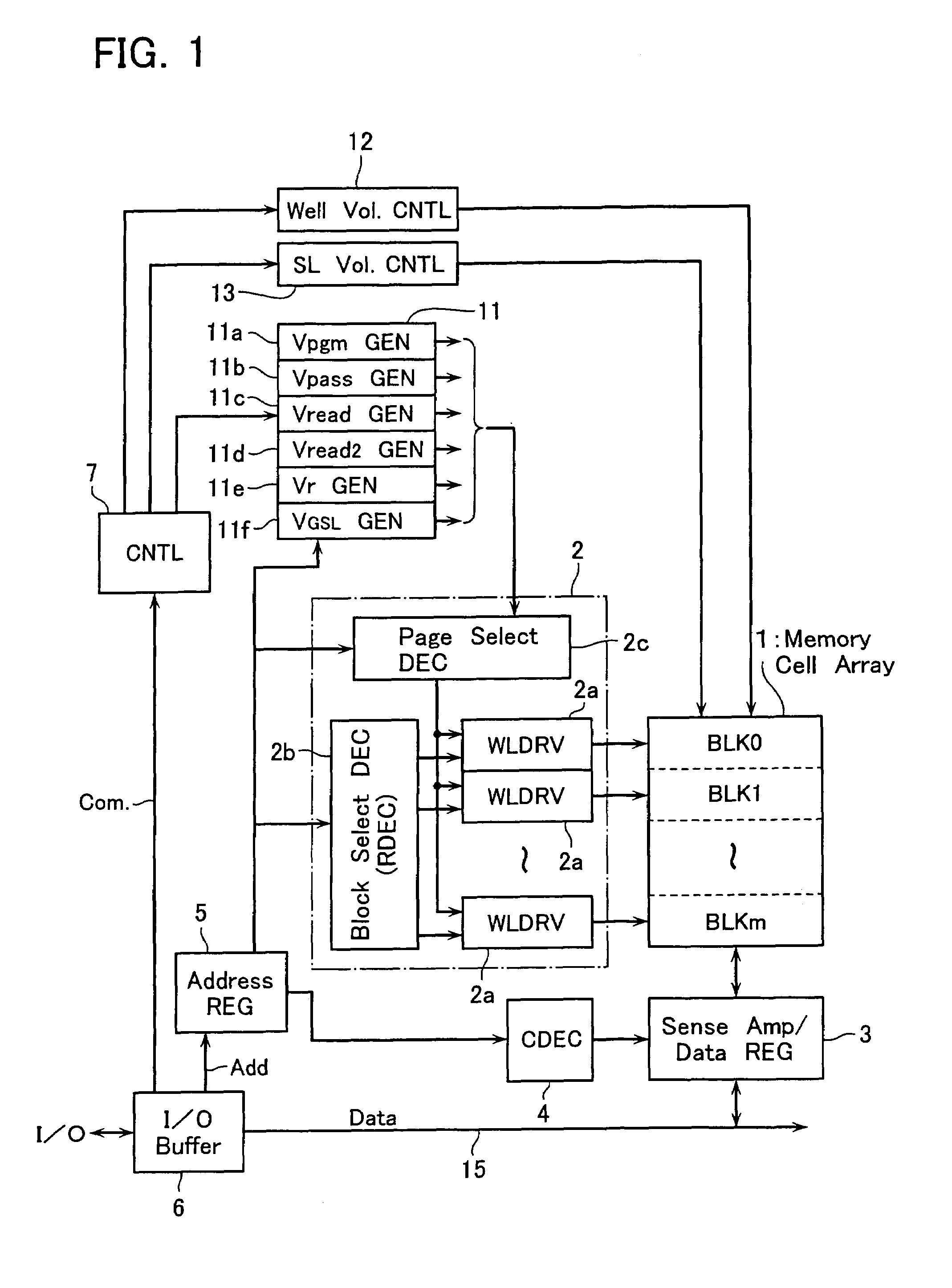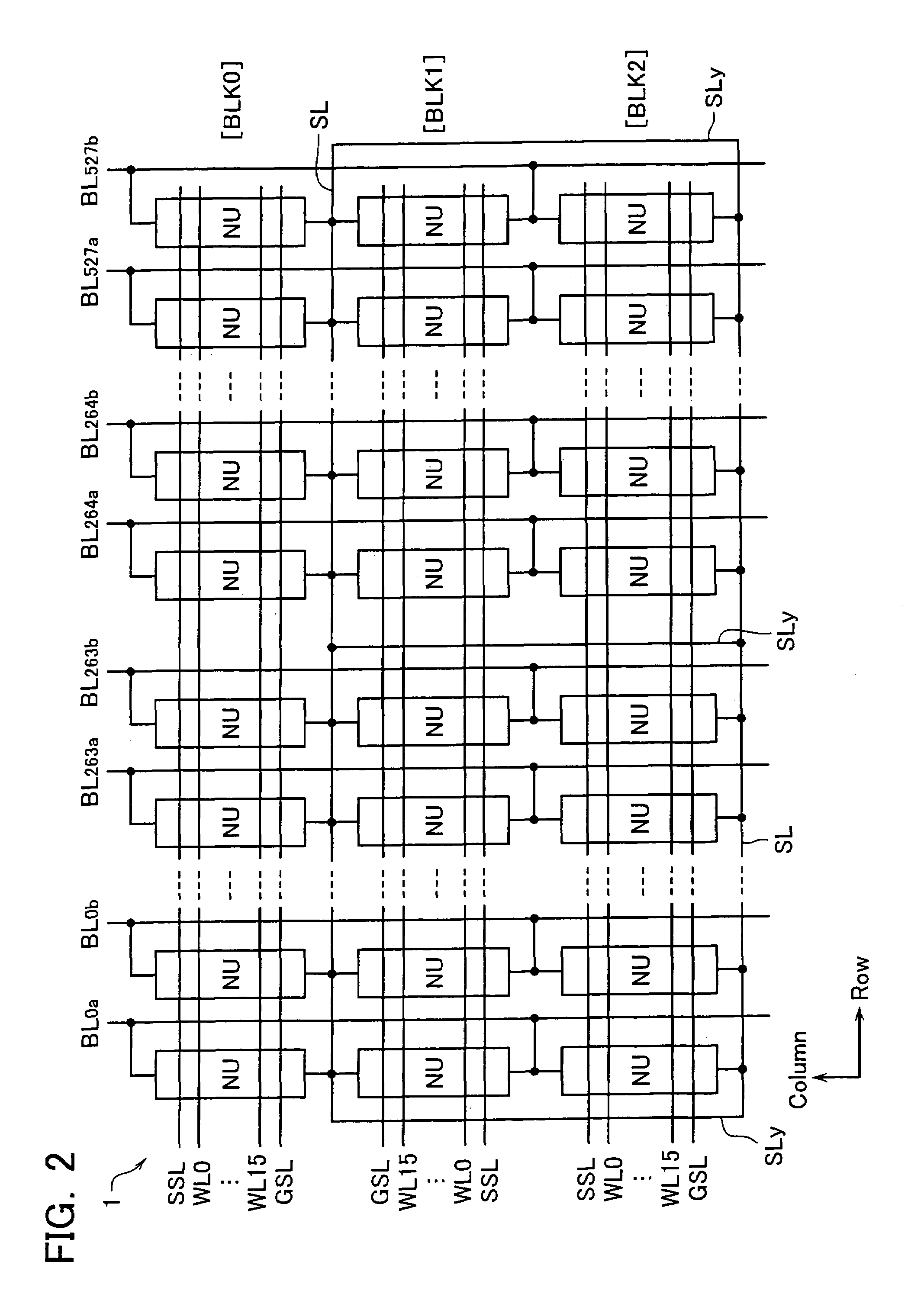Semiconductor memory device
a memory device and semiconductor technology, applied in the field of semiconductor memory devices, can solve the problems of insufficient write, difficult shortening the read time and reducing electro-magnetic noise, and the threshold voltage of the memory cell appears to be varied,
- Summary
- Abstract
- Description
- Claims
- Application Information
AI Technical Summary
Benefits of technology
Problems solved by technology
Method used
Image
Examples
embodiment 1
[0056]FIG. 1 shows a functional block configuration of a NAND-type EEPROM in accordance with an embodiment 1. FIGS. 2 and 3 show the memory cell array 1 and sense amplifier circuit 3 connected to it, respectively. The cell array 1 is formed of memory cell units (i.e., NAND cell units) NU arranged in row and column directions, each of which has a plurality of memory cells connected in series.
[0057]Each NAND cell unit NU is connected between a data transfer line BL (refers to as a “bit line” hereinafter) elongated in the column direction and a reference potential line SL (refers to as a “common source line” hereinafter) elongated in the row direction. Data control lines (refers to as “word lines” hereinafter) WL(WL0–WL15) for selectively driving memory cells in the NAND cell unit NU and select gate lines SSL, GSL for block selecting are disposed common to the NAND cell units MU arranged in the row direction.
[0058]To sense bit line data of the memory cell array 1 and to hold a write da...
embodiment 2
[0156]Next, another embodiment 2 will be explained, in which the read current is carried from the common source line SL to the bit line BL in contrast to the above-described embodiment 1. The EEPROM configuration shown in FIG. 1 to FIG. 6C and the Vread generator shown in FIGS. 9 and 10 are used as there are in this embodiment 2.
[0157]FIG. 14 shows a data read timing chart in this embodiment 2, which corresponds to that shown in FIG. 7 in the embodiment 1. An example of the pass voltage Vread set in this embodiment is shown in FIGS. 15A to 15D, and FIGS. 16 and 17 which correspond to FIGS. 8A to 8D, and FIGS. 12 and 13, respectively, in the above-described embodiment.
[0158]In this embodiment, a memory cell coupled to one bit line BLxb within the bit lines BLxa and BLxb shown in FIGS. 2 and 3 is subjected to data read by the sense amplifier, and the other, unselected bit line BLxa is fixed in potential at substantially the same level as the source line SL so as to serve as a shield l...
embodiment 3
[0187]EEPROM flash memories in accordance with the above-described embodiments may be adapted to various applications such as flash memory cards installed detachable to various electric devices, and other flash memory systems.
[0188]FIG. 23 shows a flash memory system, which is another application example of the EEPROM chip incorporating the principles of any one of the embodiments 1 and 2 stated supra. This flash memory system is generally made up of a host platform 601 and its associated universal serial bus (USB) flash device 602. The host platform 601 is connected to the USB flash device 602 through a USB cable 605. Host platform 601 is connected by a USB host connector 604 to USB cable 605. USB flash device 602 is connected to USB cable 605 via a USB flash device connector 606.
[0189]The host platform 601 has a USB host controller 603 for controlling packet data transmission over a USB bus(es). The USB flash device 602 has at least one flash memory module 608 and a USB flash devi...
PUM
 Login to View More
Login to View More Abstract
Description
Claims
Application Information
 Login to View More
Login to View More - R&D
- Intellectual Property
- Life Sciences
- Materials
- Tech Scout
- Unparalleled Data Quality
- Higher Quality Content
- 60% Fewer Hallucinations
Browse by: Latest US Patents, China's latest patents, Technical Efficacy Thesaurus, Application Domain, Technology Topic, Popular Technical Reports.
© 2025 PatSnap. All rights reserved.Legal|Privacy policy|Modern Slavery Act Transparency Statement|Sitemap|About US| Contact US: help@patsnap.com



